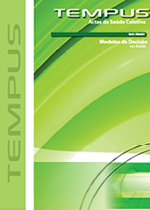Abstract
This study aimed to provide a probabilistic decision model for sepsis, early diagnosis. The data contained in the medical records of 100 individuals admitted to a general ICU in a public hospital in the inland of the State of Paraiba were analyzed, in the period from March to September, 2011. The studied variables were: age, gender, initial diagnosis, minimum and maximum axillary temperature, heart and breathing rate, oxygen and carbon dioxide partial pressure, lactate serum levels, potassium, sodium, total count of leukocytes, bands and segs., among others. The binary logistic regression were used to determine the prediction model, and data were analyzed by SPSS software, version 19.0. 63% of the subjects were male, with a 62.5 year average age. as explanatory variables the following were considered: minimum axillary temperature, maximum axillary temperature, carbon dioxide partial pressure, lactate, white blood cell count and number of bands. Through ROC curve we identified the ideal cut-off point for classifying the subjects with regard to the presence or absence of disease, which has contributed to formulating the decision-making rule for sepsis early diagnosis. The concordance degree were compared between blood culture result regarded as gold standard for infection diagnosis and the model submitted in the study using Kappa coefficient, obtaining a 0.93 concordance percentage, regarded as outstanding. It was demonstrated being possible to carry out sepsis early detection adopting statistical models as the submitted one, however, new studies with populations from different ICUs must be performed in order to provide a better casuistry, making the found results reproducible in different clinical situations.A Tempus garante critérios rigorosos, por meio de avaliação sistemática. Os autores se responsabilizam pela veracidade e ineditismo do trabalho cabendo a eles a cessão de direitos de publicação à revista. A confiabilidade dos conteúdos e a marca própria de apresentação tem como objetivo uma comunicação personalizada, adaptada aos padrões da revista, na medida em que adota critérios de excelência exigidos por seus usuários e especialistas, considerando os rigores da comunicação científica. Os autores devem especificar sua contribuição individual na concepção, delineamento, execução do trabalho, análise ou interpretação dos dados, redação e aprovação final do manuscrito. Incluir Fontes de financiamento e de apoio logístico das pesquisas. Ao final da submissão do artigo, os autores devem enviar uma declaração de cessão de direitos de publicação à Revista TEMPUS , assinada e no formato PDF (Portable Document Format ): Modelo da declaração de cessão de direitos.
